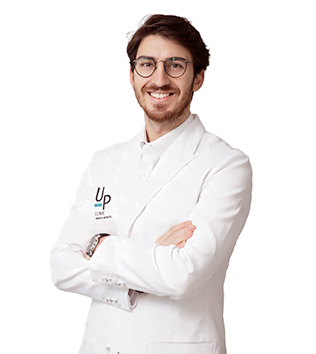Dark circles
Dark circles are the common term, characterized by dark and/or swollen areas under the eyes, being a common problem that affects many people. These spots can appear due to a number of reasons, including genetic factors, lack of sleep, aging skin and even allergies. Dark circles under the eyes can not only create an appearance of tiredness and fatigue, but can also affect self-esteem. At Up Clinic, we are committed to offering effective solutions for the treatment of dark circles non-surgically (when possible) by the aesthetic medicine team.
What are Dark Circles?
Dark circles, the common term, are characterized by dark and/or swollen areas under the eyes, and they are a frequent issue that affects many people. These marks can appear due to a variety of reasons, including genetic factors, lack of sleep, skin aging, and even allergies. Dark circles can not only create an appearance of tiredness and fatigue but also impact self-esteem. At Up Clinic, we are committed to offering effective non-surgical solutions for the treatment of dark circles by our team of aesthetic medicine experts.
The Importance of Dark Circle Treatment
Dark circle treatments play a vital role because the eyes are the most important aesthetic unit of our face. They are the first thing we look at when meeting someone new. Through the gaze, we can perceive various emotions, which is why the gaze is considered the window to our soul!
Types of Dark Circles and Dark Circle Treatments
There are four types of dark circles:
- Structural Dark Circles: Also known as deep dark circles, these are the classic type resulting from a lack or loss of subcutaneous tissue. They are ideally treated with hyaluronic acid fillers.
- Vascular Dark Circles: With a bluish hue, these circles vary with fatigue and sleepless nights. The treatment for vascular dark circles involves improving blood vessel tone and lymphatic drainage using local cold therapy, massages, and products containing ingredients like caffeine or similar compounds. In some cases, vascular ablative lasers may be considered.
- Pigmented Dark Circles: These dark circles are caused by the accumulation of pigment. They have a brownish color if melanin is the pigment and a purplish color if the pigment is hemoglobin or one of its derivatives (bilirubin, iron). Treating pigmented dark circles is complex and involves multiple approaches, including depigmentation methods like microneedling or chemical peels, as well as collagen stimulation and skin quality enhancement methods like smooth PDO threads.
- Bag-Related Dark Circles: This type of dark circle mainly results from the aging process and tissue fragility, allowing for herniation of intra- and infraorbital fat pockets. Treatment for bag-related dark circles is surgical, although in some situations, aesthetic procedures can help conceal and improve their appearance.
However, it’s common to have a mix of various types of dark circles, which increases the complexity of their treatment and underscores the importance of a proper clinical diagnosis.
Eye Aging and Periocular Rejuvenation
At Up Clinic, we approach dark circle treatment not as isolated aesthetic units but as a region—the periocular region—due to its complexity and multiple contributing factors.
When we think of dark circles, we typically refer to the medial area of the lower eyelid. However, periocular aging and its rejuvenation involve much more than this small area.
Periocular aging encompasses orbital bone resorption with eye socket sinking and external eye rotation, loss of volume in maxillary and temporal fat compartments, and tissue ptosis. This results in:
- Sunken eyes
- External rotation and drooping of the lateral eye corner
- Drooping of the brow and upper eyelid (crow’s feet wrinkles)
- Visibility of ligaments and underlying structures (dark circles)
- Herniation of intra- and infraorbital fat pockets (“festoons”)
As you can see, periocular aging is a comprehensive and complex process involving various structures. To achieve a harmonious and truly satisfying result, it is essential to evaluate all elements during the consultation, which is why we at Up Clinic approach periocular rejuvenation as a holistic process.
Procedure
Depending on the assessment, treatment may involve filling only the medial area of the lower eyelid (dark circle) or a more comprehensive treatment of the entire periocular region. The number of syringes needed varies, on average, from 1 to 3, and the procedure is performed using a cannula. Complementary treatment with botulinum toxin is often recommended, as it enhances the results.
In cases of pronounced eyelid sagging or herniation of fat pockets, the first step in the clinical assessment is to rule out surgical indications.
Benefits
- Rejuvenation of the gaze
- Improvement of the tired and sad appearance
- Improvement of deep dark circles
- Improvement of periocular wrinkles
- Beautification and enhancement of self-esteem
Who Is It For?
This treatment is suitable for anyone looking to improve the tired and sad appearance of their eyes, restoring brightness to their gaze.
Additional Treatments
- Upper third botulinum toxin
- Facial harmonization with a focus on 3M restructuring
- Temporal filling
- Injectable collagen stimulators
- Threads
- Liftera (Micro- and macro-focused ultrasound)
- Ablative or non-ablative lasers
- Chemical peels
- Microneedling with drug delivery
- Profhilo
- Skinboosters
- Personalized Skincare routine
- Others
Contraindications
- Allergy to any of the components
- Active and uncontrolled autoimmune disease
- Active and uncontrolled inflammatory disease
- Active local infection
- Severe coagulation disorders
- Under 18 years old (relative and dependent on indication and legal guardian authorization)
- Pregnancy
- Breastfeeding (relative)
- Severe and uncontrolled psychological disorder
Other Information
- Anesthesia: Anesthesia is used in all procedures.
- Duration: Approximately 1 hour on average.
- Results: Initial results are immediate, with final results appearing after 15 days of the procedure.
- Downtime: N/A
Select your section.
ESPECIALISTAS
CLÍNICA
Conheça as nossas instalações
A Up Clinic nasceu com o intuito de oferecer uma experiência de excelência na área de estética e bem-estar. As instalações da clínica em Lisboa foram criadas com o objectivo de proporcionar o máximo conforto num ambiente elegante e exclusivo, sem descurar a proximidade que caracteriza a equipa multidisciplinar da clínica.
Processo
O tratamento de olheiras é um procedimento não cirúrgico com uma duração de 30 minutos e é realizado sem anestesia. É um procedimento que não necessita de internamento e não tem um período de baixa. Os resultados finais são imediatos. Deverão ser considerados as seguintes inibições para o tratamento de olheiras: 24h de inibição de atividade física, voar e exposição solar.
Necessária consulta médica para diagnóstico e avaliação da existência de finalidade terapêutica.
Duração
30 min
Anestesia
Não tem
Internamento
Não tem
Período
de baixa
Não tem
Resultados
Imediatos
Inibição de atividade física
24 horas
Inibição de
voar
24 horas
Inibição de conduzir
Não tem
Inibição de atividade sexual
N/a
Inibição de exposição solar
24 horas




